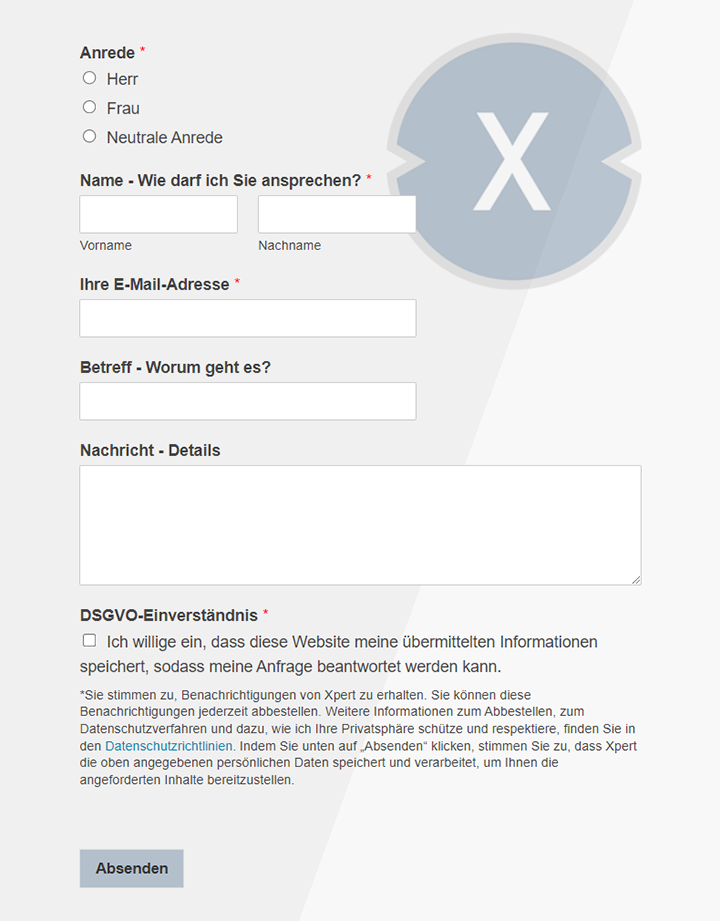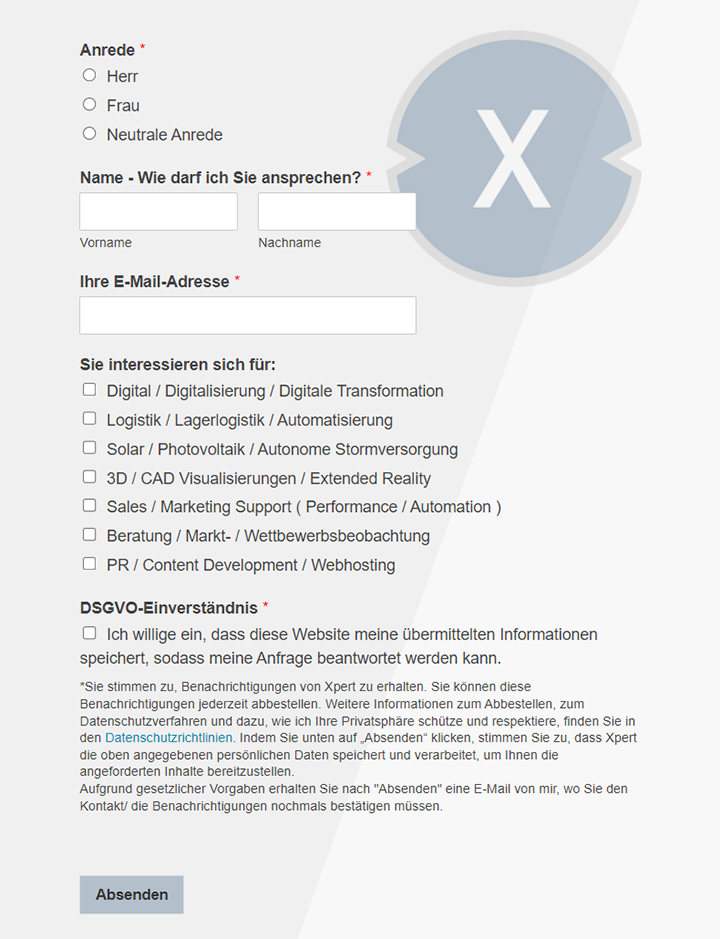Military logistics 4.0: The future of military supply chains - automation and civilian infrastructure as strategic factors for NATO
Xpert pre-release
Language selection 📢
Published on: April 17, 2025 / update from: April 29, 2025 - Author: Konrad Wolfenstein

Military logistics 4.0: The future of military supply chains - automation and civilian infrastructure as strategic factors for NATO - Image: Xpert.Digital
Military efficiency newly thought: Technologies of Logistics 4.0 (reading time: 34 min / no advertising / no paywall)
Networked troops: The role of smart logistics in modern military operations
The military logistics, traditionally the science of the planning and implementation of the movement and care of armed forces, goes through a fundamental change, which is promoted by the principles and technologies of "Industry 4.0". This change, known as "military logistics 4.0", marks a departure from traditional, often reactive approaches to integrated, data -controlled and increasingly automated systems.
Suitable for:
- Defense logistics: Germany's key role in the NATO strategy-how AI and robots can advance the Bundeswehr
Tailor -made solutions: Why standard technologies for military logistics are not sufficient
The origins of logistics are deep in the military system, where the efficient supply of supplies and equipment has always been decisive for the war. Logistics 4.0 builds on this historical meaning, but integrates modern digital technologies in order to meet the complex requirements of modern military operations. It is not just the introduction of new technologies, but also a paradigm shift towards networked, intelligent and autonomous logistics systems that enable continuous connectivity and visibility of the supply chain. This approach aims to improve the effectiveness and efficiency of entire supply chains and to develop logistics from a pure cost center to a strategic competitive factor.
In essence, logistics 4.0 integrates progressive technologies such as the Internet of Things (IoT), artificial intelligence (KI), big data analytics and cyber-physical systems (CPS) into logistical processes. The goal is to optimize resources, improved tracking and increased efficiency. A distinction is made between instrumented logistics (technology use to improve material envelope), networked logistics (combination of logistics devices to improve tracking and traceability) and intelligent logistics (AI-based skills for autonomous decision-making and process optimization).
While military logistics 4.0 benefits from commercial developments, it differs in its goals and specific requirements. The focus is not on maximizing profits, but on maintaining operations, combat power, operational operational readiness and support for the group in various and often competitive environments. This includes unique activities such as design, development, procurement, storage, distribution, maintenance, personnel transport and infrastructure management. The adaptation of commercial technologies to these specific military requirements such as resilience, security and surgical ability under adverse conditions is therefore crucial. This convergence of commercial technological progress and specific military requirements means that a simple takeover of standard solutions is not sufficient; Rather, tailor -made adjustments and developments are necessary in order to meet the special challenges of the military spectrum of use.
Key technologies and applications
The transformation to military logistics 4.0 is made possible by a number of key technologies:
Internet of Things (IoT) & Cyber-Physical Systems (CPS)
IoT forms the basis for real -time communication, consistent connectivity and transparency in the supply chain. Sensors of goods (packaging, pallets), vehicles and in camps continuously record data about the location, condition and movement. CPS describe networks in which digital and physical objects interact and communicate. Applications include "smart warehousing" with automated inventory management, condition monitoring (e.g. cold chains), optimized warehousing and automated picking, packaging and shipping processes. A challenge in the military context are limited or uncertain network connections; Edge computing, in which data is processed decentrally, offers potential solutions to minimize bandwidth requirements and transmission paths.
Artificial intelligence (AI) & machine learning (ML)
KI/ML analyze huge amounts of data for creating forecasts (demand forecasts, detection of potential disorders, optimization of resource allocation). They enable forward -looking maintenance (predictive maintenance) by predicting the failure of components before it occurs. This reduces unplanned downtime, saves costs and increases operational security. AI automates processes and supports the decision -making process, optimizes transport routes and processes large amounts of battle field data to improve the location of the location and accelerate decisions. Studies indicate efficiency increases of 20% or more.
Big Data Analytics
Use extensive, structured and unstructured data to recognize patterns, predict scenarios, identify bottlenecks, optimize processes and to improve the situation awareness. This is crucial in order to obtain action -relevant information from complex supply data.
Autonomous systems & robotics
Comprises unmanned soil vehicles (AGVS), unmanned aerial vehicles (UAVS/drones) and automated storage systems. (Detailed view in Section II).
Blockchain
Offers increased security, transparency and efficiency for logistical operations. It enables the safe real-time tracking of deliveries and equipment, reduces the risk of fraud, theft and counterfeiting and improves accountability. The US Department of Defense actively examines the use of blockchain to improve the traceability and safety of its supply chain. “Smart contracts” can also automate processes.
Digital twins (digital twins)
Virtual replicas of physical objects, systems or environments (up to battlefield conditions). They are used for scenario management, mission samples, training and forward -looking maintenance to reduce risks and improve results.
Cloud computing
Enables storage, processing and access to large amounts of data and often forms the technological basis for other logistics 4.0 applications. It supports multi-party network solutions for improved cooperation.
Extended reality (Augmented Reality - AR)
Offers potential to improve process quality, avoid errors and increase employee productivity, for example through visual support in picking or maintenance tasks in warehouses.
Additive production (3D printing)
Modernizes the production and maintenance of equipment, the production makes it more efficient and supply chains resilient, in which spare parts can be produced as required and decentrally.
Recognize weaknesses, take advantage of opportunities: the systemic nature of modern military technologies
The common denominator of all of these technologies is the central importance of data: its production, transmission, analysis and use in real time or almost real time. This makes data management, data security and, above all, data inter -operability the crucial challenges and the greatest opportunities of military logistics 4.0. Success depends less on individual technologies than on the establishment of a robust, safe and interoperable data ecosystem, which enables the seamless flow of information across system and organizational limits- a direct connection to the goals of NATO's digital transformation. A failure in data management undermines the entire concept.
In addition, these technologies are strongly dependent on each other. AI needs big data and data from IoT sensors; Blockchain can increase the safety of IoT data; Autonomous systems use AI and IoT data for their operations. This interdependence creates a complex overall system. Weaknesses or failures in a component can have cascading effects on other parts of the system. The implementation therefore requires a holistic system approach that takes into account the integration and interactions of the technologies instead of looking at it isolated. This systemic nature increases both the potential advantages and the risks; For example, a single cyber weak point in the IoT could compromise the AI decisions based on it.
Effects of automation and robotics on military logistics
Automation and robotics revolutionize military logistics by increasing efficiency and security, but also bringing new challenges.
Increasing efficiency and operational effectiveness
The introduction of automated systems leads to significant increases in efficiency in various areas of military logistics:
- Automation of tasks: Robot take on dangerous, difficult or monotonous tasks such as loading and unloading supply goods, transportation through dangerous terrain, bombing or dealing with hazardous substances. This relieves human staff who can focus on higher quality, strategic tasks.
- Care transport: Autonomous soil vehicles (AGVs) convey ammunition, medical material and equipment independently or remotely, which increases operational efficiency. "Leader-Follower" systems enable a manned management vehicle to control several unmanned trucks in convoys, which reduces personnel requirements. The US army tests such systems intensively.
- Monitoring & Enlightenment: Unmanned aircraft (UAVS/drones) provide real-time information data, improve the position of the position and accelerate the decision-making process. AI-supported drones can identify threats and pursue movements.
- Foresight maintenance: AI systems analyze sensor data of vehicles and devices to predict maintenance requirements before failures occur. This reduces unplanned downtime, reduces maintenance costs and increases the availability of material.
- Manufacturing & resilience of the supply chain: "Smart Manufacturing" technologies such as 3D printing enable more efficient and flexible production of spare parts and equipment, which strengthens the resilience of the supply chain. Automated manufacturing processes also increase production volume and precision.
- Data processing & decision support: AI algorithms process huge amounts of data faster than humans, recognize patterns, forecast needs and proposal options. This leads to faster response times and better planning. Robotic Process Automation (RPA) automates routine tasks such as data entry or reporting and saves significant personnel lessons, as examples of the US Coast Guard and the Defense Logistics Agency (DLA).
Improvement of security and reducing human risks
An important advantage of automation is to reduce the dangers for soldiers:
- Use in dangerous environments: AGVs and UAVs can operate in areas that are too dangerous for humans, be it through mines, explosive traps, enemy fire or contaminated terrain. Robots take care of hazardous substances such as ammunition.
- Reduced personnel exposure: The automation of transport, monitoring or security tasks reduces the number of people who have to stay in high-risk zones. "Leader-Follower" convoy reduces the number of drivers that are exposed to potential attacks in convoys.
- Increased precision: Robots carry out tasks with high precision, which minimizes human errors in critical or dangerous activities, for example in manufacturing or when dealing with explosives.
Cybersecurity vs. Automation: The growing attack area decrypted
Despite the advantages, increasing automation also harbors considerable risks:
- Cybersecurity weak spots: Networked and automated systems create new attack vectors for opponents. Securing these systems against highly developed cyber attacks is complex and essential, since compromises can endanger critical infrastructures and classified information. AI-supported systems for threat detection are used, but the attack surface remains large.
- Ethical and legal dilemmata: The use of autonomous systems, especially armed systems (AWS), raises fundamental ethical questions: Who is responsible for autonomous decisions? How can unintentional damage be avoided? Is it morally justifiable to delegate decisions about life and death on machines? The lack of international regulations for AWS tightens the concerns about uncontrolled distribution and escalation risks.
- Integration complexity: The integration of new automated systems into existing (often outdated) infrastructures and the guarantee of interoperability between systems of different nations or manufacturers represent significant technical and organizational hurdles. Finding the balance between automation and human expertise is difficult because human judgment often remains essential in complex situations. Errors in software development or poorly designed human-machine interfaces can lead to accidents or system failure.
- Dependencies in the supply chain: The dependence on foreign suppliers, especially for critical components such as sensors or processors (e.g. from China), creates strategic vulnerability and security risks for robotic systems. Diversification of the supply chains and promotion of domestic production are necessary to reduce these risks.
- Costs and personnel development: High implementation costs for new technologies, infrastructure adjustments and maintenance strain defense budgets. At the same time, the change requires an adaptation of the workforce through retraining and further training in order to keep up with the technological development. There is also concern about job losses in traditional logistics areas.
- Reliability and trust: The guarantee of the reliability of autonomous systems under the rough and unpredictable conditions of the battlefield is crucial. Software errors, unexpected system behavior or environmental influences can have serious consequences. The structure of trust between human users and autonomous systems is a fundamental prerequisite for their effective use.
The introduction of automation and robotics thus represents a double -edged sword. The convincing advantages in terms of efficiency and security go hand in hand with complex, potentially systemic risks in the areas of cybersecurity, ethics and supply chain dependency. These advantages can only be realized if the risks are managed proactively. A balanced approach is required that not only focuses on technological performance, but also on a safe, ethical and resilient implementation.
This technological integration fundamentally changes the role of military staff. Instead of performing tasks directly, the focus is on surveillance, data analysis and management of autonomous systems. This requires new skills and training paradigms, away from pure operator to the system manager and analysts, which results in significant adjustments in training and doctrine (e.g. in the Dotmlpfi spectrum).
Although automation can accelerate logistical processes (e.g. transport, data analysis), integration problems, potential system failures and the need for ethical or legal reviews of autonomous actions could introduce new latency times or frictions. This could overturn some of the speed advantages, especially with complex operations. The net effect on the pace of operations therefore depends heavily on the scenario and requires careful management of the human-machine interface and high system resilience.
Suitable for:
- Autonomous mobile robots (AMR) and artificial intelligence (AI): cost reduction and efficiency boost in intralogistics
Civil infrastructure: strategic cornerstone of NATO logistics
NATO's ability to use and supply their armed forces to a large extent depends on the availability and functionality of civil infrastructure. This dependence makes civilian infrastructure a strategic cornerstone of alliance defense and logistics.
Strategic importance for NATO operations
The dependence of NATO on civil resources is fundamental. Military operations, especially in crisis and conflict times, are strongly based on the civilian and commercial sector for transport services, communication networks, energy supply and even basic goods such as food and water. Already during the Cold War there were logistical considerations based on a robust infrastructure, a central part of NATO's deterrent and defense planning.
- Transport networks: streets, railways, ports, airports and waterways are essential for the laying of troops and material. According to large NATO operations or exercises, around 90% of military transports are handled over civilian capacities (ships, trains, aircraft). The dense network in Germany plays a key role for relocations to the eastern flank.
- Communication networks: Civil telecommunications and data networks are crucial for leadership and control (Command and Control- C2), data exchange and coordination of military operations. A significant part of the satellite communication for defense purposes is provided commercially.
- Energy supply: A secure energy supply is critical of the operation of military systems and facilities. Military activities are significantly dependent on civilian energy networks and fuel supplies. The fuel logistics, including storage, pipelines (such as the NATO Pipeline System - NPS) and transport, is particularly important on the eastern flank and is a challenge.
- Mastering the collective defense: Resilient civil infrastructure is the basis for national resilience, which in turn is a basis for credible deterrence and defense within the meaning of Article 3 of the North Atlantic Treaty. It enables NATO's core tasks: collective defense, crisis management and cooperative security. A lack of resilience of the infrastructure could lead to the armed forces cannot “get into the battle” in time.
Military mobility: concept and challenges
Military mobility describes the ability to move military personnel and material quickly and efficiently across borders using various modes of transport. It is a decisive factor for NATO's deterrent and defense ability and the EU's crisis management. Speed and responsiveness are essential. The main problems are in the following areas:
- Infrastructural restrictions: physical bottlenecks such as dilapidated infrastructure (streets, bridges, rails - especially problematic in Germany), insufficient load -bearing capacity of bridges for heavy equipment (tanks can weigh over 70 to 120 tons), different lane widths in the rail network, lack of suitable means of transport (e.g. deep charging wagons) and a lack of interpretation (civilian and military) use.
- Bureaucratic/regulatory hurdles: complex, lengthy and non -harmonized procedures for border transfer permits (diplomatic releases), customs formalities (e.g. using form 302) and the transport of dangerous goods significantly hinder quick installations. The desired processing times for permits (e.g. 5 days in the EU vs. 3 days of NATO) are often too long.
- Capacity bottlenecks: Limited availability of means of transport (railway wagons, ships, aircraft) and limited capacity of the infrastructure, especially with a high volume (surge).
- Financing gaps: Inadequate funds for necessary infrastructure moderation and projects for double use. The reduction of originally planned EU budgets for military mobility is an example.
- Cyber and physical vulnerability: Critical transport and communication infrastructures are susceptible to attacks, which can endanger mobility.
EU Nato cooperation for military mobility
Since many challenges of military mobility affect civilian responsibilities (infrastructure, regulation), close cooperation between NATO, EU and the nation states is essential. This cooperation takes place via various mechanisms:
- EU initiatives: Constant structured cooperation (PESCO) with its own project on military mobility, EU action plans for military mobility and the Connecting Europe Facility (CEF) for co-financing dual-use infrastructure projects. The orientation on the Trans Transe European transport network (TEN-T), which overlaps 93% with military needs, is central.
- Common committees and dialogues: common task forces (e.g. to resilience and critical infrastructure), structured dialogues and votes for harmonizing standards and procedures.
- Meaning: The cooperation promotes the load division, uses the EU competencies in the area of transport, infrastructure regulation and financing and addresses challenges that are outside the direct responsibility of NATO. The cooperation between the United Kingdom and the EU is still underdeveloped in this area, but important.
The strong dependence on civilian infrastructure, which is mainly privately owned and is operated civilian, creates a paradoxical situation: these systems are essential for NATO's military ability to act, but at the same time represent a significant strategic weak point - a kind of "soft underside". They can be used by opponents through physical attacks, cyber attacks or hybrid measures to hinder NATO operations. This requires robust measures to secure and resilience (Critical Infrastructure Security and Resilience - CISR) that go beyond traditional military hardening.
Coping with the challenges of military mobility serves as an important indicator ("lacquer muscle test") for the broader cooperation between NATO and the EU and for the political will of the Member States, the enabling of collective defense on national restrictions or commercial priorities. Persistent problems indicate deeper political, economic or institutional frictional losses that could also affect other areas of collective defense.
The optimization of civil infrastructure for military use (e.g. strengthening bridges, standardization of railway lines) requires considerable investments and can affect civil efficiency or commercial interests. This creates a dilemma for national governments: the prioritization of military readiness can burden civilian operators or taxpayers, while prioritizing civil and commercial use can leave critical military gaps. A balanced approach requires careful national planning and potentially incentives by NATO or EU (such as CEF agents).
🎯📊 Integration of an independent and cross-data source-wide AI platform 🤖🌐 for all company matters

Integration of an independent and cross-data source-wide AI platform for all company matters-Image: Xpert.digital
Ki-Gamechanger: The most flexible AI platform-tailor-made solutions that reduce costs, improve their decisions and increase efficiency
Independent AI platform: Integrates all relevant company data sources
- This AI platform interacts with all specific data sources
- From SAP, Microsoft, Jira, Confluence, Salesforce, Zoom, Dropbox and many other data management systems
- Fast AI integration: tailor-made AI solutions for companies in hours or days instead of months
- Flexible infrastructure: cloud-based or hosting in your own data center (Germany, Europe, free choice of location)
- Highest data security: Use in law firms is the safe evidence
- Use across a wide variety of company data sources
- Choice of your own or various AI models (DE, EU, USA, CN)
Challenges that our AI platform solves
- A lack of accuracy of conventional AI solutions
- Data protection and secure management of sensitive data
- High costs and complexity of individual AI development
- Lack of qualified AI
- Integration of AI into existing IT systems
More about it here:
Dependencies and challenges of the NATO strategy in the digital age
Influence on the NATO strategy: integration and dependency
The integration of logistics 4.0 concepts and the profound dependency on civilian infrastructure significantly shape the strategic orientation, planning and operational management of NATO.
Minting of NATO strategy concepts and planning
Modern logistics, reinforced by logistics 4.0, is recognized as a decisive factor ("critical enabler") for NATO's deterrent and defense ability. The NATO strategy emphasizes the need for resilient supply chains ("Resilient Sustainment") and recognizes the central importance of logistics for mission success. The NATO Logistics Committee (LC) plays a key role in political development and coordination.
The introduction of Logistik 4.0 technologies directly supports the more comprehensive digital transformation strategy of NATO. This aims to achieve an improved position, data -based decision -making and interoperability across all domains by 2030 through the use of technologies such as KI, Cloud Computing and Big Data.
Logistics 4.0 and a resilient infrastructure are fundamental to the ability to lead Multi-Domain Operations (MDO). They enable seamless guidance and control (C2), the orchestration of effects over domains (land, air, lake, cyber, space) as well as quick troops and their sustainable care. Concepts such as the "Digital Backbone" (digital backbone) build on this progress.
The need for faster reinforcements (e.g. in the context of the New Force Model) and credible initial defense requires highly efficient, reaction -fast logistics chains. This drives the introduction of modern logistics concepts and the dependence on powerful infrastructure. The NATO Readiness Initiative largely depends on logistical enabling.
The NATO Defence Planning Process (NDPP) takes increasing demands on logistics capacities and their enabling ("enablement"), including the skills provided by digital transformation and dependent on civil infrastructure to meet the operational plans.
Strategic implications of the dependence on civil infrastructure
The strong dependence on civil infrastructure has far -reaching strategic consequences:
- Ducking off: A credible deterrent is based on the ability to quickly move and care for armed forces. This depends crucially on accessible and resistant civilian infrastructure. Weaknesses in this infrastructure can undermine the credibility of the deterrent.
- Collective defense (Article 5): The ability to meet alliance obligations in accordance with Article 5 depends fundamentally on the military mobility over the alliance area, which is made possible by civil transport networks. Disruptions could significantly hinder collective defense efforts.
- Resilience as a core task: The emphasis on resilience by NATO combines the security of civil infrastructure (CISR) directly with the strategic goals of the alliance. The strengthening of national resilience through civilian provision is considered crucial for all core tasks.
- Strategic vulnerability: The excessive dependency creates weaknesses that could be used by opponents (e.g. attacks on traffic hubs, energy networks, communication lines) to hinder NATO operations or sow. This requires strategies that aim at protection, redundancy and quick restoration.
- There is a symbiotic relationship between strategy and technology: NATO's strategic realignment towards MDO and increased operational readiness is promoting the introduction of Logistics 4.0 technologies. At the same time, the skills and restrictions offered by these technologies (and the underlying infrastructure) shape the strategic options. The dependence on civil infrastructure forces you to firmly integrate vulnerability and resilience defects into operational concepts. Strategy not only demands new technologies; The available technology and infrastructure influence strategic possibilities and limits.
A potential risk lies at the different speed at which the alliance partner Logistik 4.0 introduces and modernize their infrastructure. This could increase the ability gap within NATO and impair interoperability and the effectiveness of collective logistics concepts. While NATO sets common goals, the implementation of national efforts and investments depends. The advanced logistics systems of a country may not be compatible with less developed systems of another, which could make joint efforts such as that of the Joint Logistics Support Group (JLSG) and could lead to a multi -level logistics ability within the alliance.
The increasing dependence on digital systems and civil infrastructure also introduces new elements into the deterrent calculation. Disposal no longer only means the demonstration of military strength, but also the demonstration of the resistance and safety of the underlying digital and physical infrastructure against cyber, hybrids and physical attacks. Since these infrastructures represent attractive goals for attacks below the threshold of an armed conflict, the demonstration of robust CISR and cyber defense skills becomes an integral part of the signaling of determination and ability. An opponent must be convinced that NATO can maintain its operations despite attacks on its enabling infrastructure.
Suitable for:
- Strategic realignment of the supply chains and logistics: A requirement of the hour - at short notice, in the medium term and long -term
Vulnerings, risks and security concerns
The progressive digitization, automation and use of civil resources in military logistics open up new possibilities, but also create significant weaknesses and security risks.
Risks of digitization and automation
- Cybersecurity threats: The increasing networking and software dependency of logistics systems, leaderships, autonomous platforms and databases creates significant attack areas for cyber attacks. Automated systems can serve as a gate. The protection of critical information and infrastructures is of the utmost importance. AI can be used for both attacks and defense.
- Data security and protection: Dealing with huge amounts of sensitive logistical and operational data requires robust security measures against unauthorized access, espionage or manipulation. The integrity of the data is crucial for decision -making.
- System complexity and failure risk: highly complex, networked systems (logistics 4.0) are susceptible to unexpected failures, software errors or cascade effects. Integration problems can lead to weaknesses.
- Ethical risks of autonomy: As shown in section II.C, there are risks in connection with autonomous decision -making, responsibility, algorithmic bias and potential for unintentional escalation.
- Supplier risks for technology: The dependence on potentially opposing or insecure sources for critical hardware and software components (e.g. chips, sensors for robots/IoT) represents a significant risk of supply chain.
Risks of the dependence on civilian infrastructure
- Physical vulnerability: critical infrastructures (ports, bridges, pipelines, power grids, communication lines) are often geographically distributed and potentially susceptible to physical attacks, sabotage or natural disasters. Sabotage files like north stream illustrate these risks. The decay of the infrastructure tightens susceptibility.
- Cyber vulnerability: The control systems of civil infrastructures (SCADA/ICS) are increasingly targeting cyber attacks. Successful attacks can cause far-reaching disorders in the transport, energy or communication sector to which the military is dependent on.
- Hybrid threats: Opponents can use hybrid tactics (disinformation, cyber attacks, use of civil dependencies) to disturb infrastructures and hinder military mobility, often with the aim of plausible abstritability.
- Opponent ownership/control: If potential opponents owners of critical infrastructures or important suppliers are or control over it, this carries risks of espionage, disruption or refusal to services.
- Capacity and availability problems: Civil infrastructures may not have sufficient capacities or are not available for military purposes during crisis due to competing civil needs, damage or commercial priorities. Ensuring the priority access requires agreements and possibly compensation.
- Interdependencies and cascade effects: The strong networking of critical infrastructures means that a failure in a sector (e.g. energy) can paralyze other sectors (e.g. transport, communication).
Interoperability challenges as a risk multiplator
A lack of interoperability between the systems of the alliance partners tightens the risks mentioned:
- System incompatibility: Missing technical, procedural or data-related interoperability between digital logistics platforms, C2 systems or autonomous units of different nations hinders the seamless coordination and data exchange. This creates operational friction losses and potential sources of error. Different national introductory speeds of new technologies tighten the problem.
- Reduced position image: The inability to effectively exchange data across different systems affects the common operational position and the situation awareness. This increases the risk of wrong decisions and inefficient resource allocation.
- Coordination errors: Communication and coordination difficulties due to non-interoperable systems can lead to delays, double work and potentially dangerous misunderstandings in complex operations.
The risks that result from digitization/automation and the dependence on civilian infrastructure are not to be considered isolated, but deeply interwoven. Cyber attacks can target both military logistics systems and civilian infrastructure controls. Late chain vulnerability concern both highly developed military technology and components of critical infrastructures. This overlap means that a single attack vector (e.g. a cyber campaign, a supply chain interruption) can also affect several facets of NATO's logistical skills. This requires integrated risk management strategies that include military and civilian areas.
The double dependence on digital systems and civil infrastructure significantly increases the susceptibility of NATO for hybrid warfare. Opponents can achieve strategic effects by attacking these "softer" civil or digital goals below the threshold of a traditional armed conflict to hinder military mobilization or to create social chaos without inevitably triggering Article 5. The digital base area of logistics 4.0 additionally expands the attack area for such hybrid campaigns.
In view of these inherent vulnerability, resilience requires more than just reactive defense. It requires proactive measures such as "security-by-design" principles, diversification of supply chains, robust hardening of the infrastructure, redundancy planning and continuous practice of reaction protocols in both military and civil sector. Resilience is therefore an active, continuous process of risk reduction and preparation, not just passive defense.
NATO applications and case studies
The implementation of modern logistics concepts and the challenges in the use of civil infrastructure are visible in NATO exercises and through specific organizational structures such as the Joint Logistics Support Group (JLSG).
NATO exercises as a test field
NATO exercises serve not only to demonstrate the operational readiness, but also as crucial test environments for new logistical concepts and to identify weaknesses:
- Trident Juncture 18 (Norway): During this exercise, autonomous systems for logistical purposes were explicitly tested, including the supply of isolated troops by hazardous zones and the protection of field camps using integrated sensor networks and remote -controlled weapon systems. The aim was to demonstrate efficiency increases and reduced personnel requirements through automation. The JLSG took over the management of the main logistics efforts and was confronted with challenges such as weather conditions and potential street bottlenecks, which illustrated the complexity of multinational major logistics and the dependence on the infrastructure of the host country.
- Steadfast Defender (series): As the largest NATO exercise series since the Cold War, these exercises serve to review new defense plans and the New Force Model (NFM). Naturally, they strain logistics and military mobility across Europe and disclose infrastructure and bureaucratic bottlenecks (e.g. the challenges in 45). They test the ability to quickly lay and supply large forces and thus implicitly modern logistics concepts and infrastructure dependency.
- Steadfast Jackal 22: This exercise focused on training and evaluation of the NATO Rapid Deployable Corps-Italy (NRDC-IT) and its associated JLSG in the planning and implementation of a smaller connected operation. This offered a practical framework to test the leadership skills of the JLSG and interoperability in a multinational environment.
- Reformer (Cold War): Although historical, these annual exercises validated the ability to lay the troops quickly to Europe and strengthen NATO positions. They underlined the long-term importance of logistics and infrastructure for the NATO strategy. The teachers from refork are still relevant for today's challenges for large -scale reinforcements.
- Steadfast Foxtrot 2023: A new logistics plan game (Wargame) that aimed to improve the understanding of roles, responsibilities and powers in large-scale ability, reinforcement and care and thus directly addressed modern logistical challenges.
- Locked Shields: Although focuses on cyber defense, this exercise includes the defense of critical IT infrastructure systems. The knowledge gained can be transferred directly to securing the digital backbone of Logistik 4.0.
These exercises are therefore essential instruments in order to validate the practical suitability of new logistics 4.0 approaches (such as autonomous care) and to identify real friction points in multinational logistics and infrastructure use (weather, traffic jams, guidance) under surgical pressure. The feedback obtained flows into the further development of doctrine and skills.
Suitable for:
The Joint Logistics Support Group (JLSG): Concept, skills and challenges
The JLSG is a specific NATO structure for coping with multinational logistics tasks:
- Concept: A unique, dispute -minded, relevant logistics ability of NATO, which provides the leadership and control (C2) via assigned logistics forces (from operational to the tactical level) to support multinational joint task force (JTF). It aims to improve logistical cooperation, optimize the logistical footprint, reduce costs, supplement national logistics and create synergies ("Economy of Effort"). It acts as a link between national support elements (NSES) and the tactical forces. Depending on the level, it can be compared with a "sustainment brigade on steroids" or US ESC/TSC structures. The doctrine is defined in AJP-4.6. There are several JLSGs (at JFC Brunsum, JFC Naples, and the Standing JLSG at Shape/Ulm).
- Skills: The JLSG provides logistical services using assigned forces, support from the host country (Host Nation Support - HNS) and contracts with civilian providers. It supports the relocation, operational care and the re -relocation of forces. It can operate logistical bases (Theater Logistics Bases- TLBS, Forward Logistics Bases- FLBS), carry out distribution and take over the management of pioneer and medical forces. The coordination of HNS and civilian service providers is also an important task. One goal is to provide the JTF commander a uniform and up-to-date logistical position.
Effectiveness & challenges (Jallc analysis): An analysis of the NATO Joint Analysis and Lessons Learned Center (Jallc) from 2015 identified several challenges that impair the effectiveness of the JLSG:
- Limited practical experience: The concept had existed for about 10 years at the time, but was rarely fully activated (once in an exercise, once in an operation), which made practical validation difficult and can affect trust.
- Dependence on national contributions: The effectiveness depends crucially on whether the nations provide sufficient funds (personnel, material).
- Personnel problems: The core stable elements (Core Staff Elements - CSE) may be understaffed. The dependence on augmentation staff requires their effective preparation and quick exemption from primary uses. The use of civil contractors for filling gaps is mentioned as a possible solution.
- Training deficiencies: lack of availability of personnel and limited joint training opportunities (CSE + Augmentieren + other units) hinder the operational readiness at the beginning of operations. More targeted training is required.
- Doctrine/political gaps: Unclear guidelines for setting up the JLSG, the role of the CSE and the formation.
- Information exchange (RLP): Difficulties in obtaining necessary data from trooping nations (TCNS) hinder the creation of a recognized logistical situation (Recognized Logistics Picture - RLP), which is crucial for the situation awareness. An agreement on minimum requirements for the RLP is recommended.
- Availability of SOPS/JDS: A lack of access to current standard procedural instructions (SOPS) and job descriptions (JDS) for the entire staff (including augmenter) affects efficiency.
- Confidence deficits: the limited demonstration, perceived defects in leadership, untrained personnel and unattended requirements undermine the trust of the nations into the JLSG concept.
The JLSG concept contains considerable potential to optimize multinational logistics in NATO. However, the analysis of the Jallc shows a clear gap between the doctrine claim and the operational reality at that time. Persistent challenges for personnel, training, national contributions and information exchange hinder the full development of this potential. Overcoming this gap is crucial for the realization of the ambitions of NATO in the field of collective logistics.
The case studies, in particular the multinational exercises and experience with JLSG, implicitly illustrate the practical challenges of interoperability. The need for connecting officers (Liaison Officers - LNOS) for bridging Technical differences, the difficulties in the exchange of information for a common position (RLP) and the high coordination effort within a multinational JLSG show the complexity to effectively merge various national systems and procedures in operations and exercises.
🎯🎯🎯 Benefit from Xpert.Digital's extensive, fivefold expertise in a comprehensive service package | R&D, XR, PR & SEM

AI & XR 3D Rendering Machine: Fivefold expertise from Xpert.Digital in a comprehensive service package, R&D XR, PR & SEM - Image: Xpert.Digital
Xpert.Digital has in-depth knowledge of various industries. This allows us to develop tailor-made strategies that are tailored precisely to the requirements and challenges of your specific market segment. By continually analyzing market trends and following industry developments, we can act with foresight and offer innovative solutions. Through the combination of experience and knowledge, we generate added value and give our customers a decisive competitive advantage.
More about it here:
Differentiated strategies: NATO members and the implementation of logistics 4.0
Comparative analysis of the approaches of NATO member states
The implementation of logistics 4.0 and the securing of civil infrastructure for military purposes are not uniform in the NATO member states. National priorities, budgets, industrial capacities and integration into EU structures lead to different approaches and speeds.
Implementation of logistics 4.0
In general, nations recognize the need to modernize their military logistics through the use of Industry 4.0 technologies (KI, IoT, blockchain etc.) in order to increase efficiency, transparency and reactionability. However, the degree of implementation and the specific focal points vary considerably. Some nations may be pioneers in certain areas (e.g. USA for blockchain explorations, UK with a focus on MDO, Italy mentions logistics 4.0 in modernization programs). An evaluation of Industry 4.0 introduction in Turkey shows early phases and challenges such as financing and shortage of skilled workers, which could indicate similar problems in other countries. Common challenges are likely to include financing bottlenecks, the integration of new technologies into old systems, cyber security concerns, qualification gaps in personnel and the guarantee of interoperability with NATO standards and allies.
Securing civil infrastructure for military use
The protection of critical infrastructures is primarily national responsibility. The approaches vary depending on the national legal framework, threat perceptions and property models (often private sector). The seven basic NATO requirements for national resilience offer a common framework, the continuity of the government, energy, transport, communication systems, food/water supply, mass accompanying and dealing with population movements. However, implementation takes place nationally. An overall-state approach ("Whole-of government") is increasingly propagated to coordinate civil and military efforts.
For EU members, EU guidelines (e.g. NIS 2, CER Directive) and financing instruments (CEF) also shape the national approaches to protect critical infrastructures and to promote dual-use skills.
- Germany: faces considerable challenges due to ailing infrastructure (rail, bridges) and bureaucracy, which affects its role as a central hub. Efforts to improve are in progress, but financing and implementation remain problematic. A planned criticism law is intended to improve certification.
- United Kingdom: Traditionally strong focus on expedition missions, with logistics being neglected in previous plans. Follows the MDO concept. After Brexit, the cooperation with EU defense initiatives (such as military mobility) is less integrated than with partners such as Norway, although a depression is sought.
- France: Traditionally emphasizes strategic autonomy alongside NATO obligations. Has significant defense industrial capacities and military satellite skills.
- Poland: Building its military skills and defense spending in response to the Russian threat rapidly. Probably prioritized infrastructure and logistics modernizations on the eastern flank. Develop unmanned ISR capabilities and set up maintenance centers for material used in Ukraine.
- Italy: mentions logistics 4.0 in the context of modernization programs of the armed forces and the participation in European research programs (EDF).
NATO promotes standardization agreements (Stanags) for procedures, systems and equipment to improve interoperability in logistics and infrastructure use.
Military mobility strategies
For most European NATO allies, the EU framework (pesco project, action plans, TEN-T connection) forms the central mechanism to improve military mobility, with a focus on dual-use infrastructure, harmonization of processes and digitization. However, progress in national implementation is different. Germany's challenges illustrate the difficulties. Other nations such as the Netherlands (as transitland) focus on infrastructure, regulation and digital requirements. Sweden develops special logistics battalions for coastal and Baltic Sea operations. Close NATO-EU coordination is essential to coordinate military requirements (NATO) with infrastructure development and regulatory framework (EU/national). Networks of national contact points (NPOCs) and movement control centers are intended to improve coordination.
Comparative overview of selected NATO countries-logistics 4.0 and mobility in focus

Logistics 4.0 and mobility in focus: Strategies of leading NATO countries (simplified overview)-Image: Xpert.digital
The table offers a simplified overview of the approaches of some key states:
The NATO member states pursue different approaches in the area of logistics 4.0 and military mobility. The United States occupies a leading position in technology development, with the Ministry of Defense increasingly relating to blockchain technology, artificial intelligence and cloud solutions. The focus is on global power projection and reliability, while improvements are required by European partners. Germany, as the country of origin of Industry 4.0 concept, is located in the middle of the implementation of corresponding technologies, but fights with considerable infrastructure challenges such as dilapidated seemed and bridges. Germany plays a key role as the central transitland, but is faced with bureaucracy and capacity bottlenecks.
Great Britain focuses on multi-domain operations (MDO), but sometimes neglects logistical aspects in strategic checks. With robust cyber skills and historical expedition experience, the country relies on bilateral collaborations and, despite Brexit, strives for closer EU connection. France emphasizes its strategic autonomy and has a strong defense industry. Participation in EU initiatives is supplemented by own capacities such as satellite systems, with the focus on sovereignty and European projects.
In view of its geographical location on the NATO east flank, Poland quickly builds up skills and prioritizes infrastructure expansion. The country takes part in EU initiatives, focuses on fast reinforcement options and develops maintenance centers and ISR capabilities (intelligence, surveillance, reconnaissance). Italy mentions logistics 4.0 in its modernization plans, participates in the European defense fund and focuses on its efforts, especially on the Mediterranean.
All states mentioned consider the securing of civil infrastructure as a national responsibility, with the approaches from Germany's planned criticism law to the robust cyber defense systems of the United States and Great Britain.
NATO faces the challenge of a "patchwork modernization" ("Patchwork Modernization"). The alliance partners introduce logistics 4.0 technologies and address infrastructure and mobility problems at different speeds and with varying priorities, driven by national budgets, threat perceptions and industrial skills. This creates persistent interoperability problems and leads to a heterogeneous capacity landscape rather than a uniformly modernized force.
For the majority of European NATO allies, the EU framework (Pesco, CEF, action plans) is becoming a central mechanism for coping with military mobility and dual-use infrastructure. However, its effectiveness is limited by restricting financing and the complexity of the coordination of EU and NATO efforts. The EU is therefore an important but complex and not perfect factor for strengthening European military ability to act within NATO.
National approaches to ensure civil infrastructure often prioritize domestic needs and regulations that do not always match the collective requirements of NATO to quick, large-scale military transit and access rights. This inherent tension means that national rules that have been designed for peace or civilian priorities can hinder the speed and flexibility required by NATO for collective defense. This requires continuous dialogue and harmonization efforts.
Conclusion and the future outlook
The integration of logistics 4.0 concepts and the strategic dependency on civil infrastructure are redefining the future of NATO military supply chains. This transformation poses considerable potential, but also presents the alliance with profound challenges and risks.
Synthesis of the results
The analysis has shown that logistics 4.0 has the potential to fundamentally change the Military Logistics of NATO in terms of efficiency, transparency and responsiveness through technologies such as AI, IoT, Big Data and Autonomous Systems. At the same time, NATO is critical of civilian infrastructures (transport, communication, energy) for the relocation and care of its armed forces, which creates significant vulnerability- physically, cyber and hybrid. Automation and robotics offer clear advantages with efficiency and security, but also bring complex risks in the areas of cybersecurity, ethics, integration and supply chain dependency. These trends significantly influence the NATO strategy, especially in the context of multi-domain operations, digital transformation and the further development of the deterrent and defense ability. Central challenges remain the guarantee of interoperability between the allies, ensuring sufficient financing, establishing common standards, coping with different national implementation speeds and increasing the effectiveness of multinational logistics structures such as the JLSG.
Opportunities for NATO
The NATO offers significant opportunities the consistent use of logistics 4.0:
- Information superiority: real -time data and analyzes can lead to a superior information situation and faster, more sound decisions in the logistics sector.
- Increased operational readiness: Optimized logistics and improved military mobility can increase the ability to react, speed of laying and maintenance of NATO forces.
- Starked deterrence: The demonstration of resilient and technologically advanced care skills strengthens the credibility of the deterrent.
- Improved alliance cohesion: Common logistics initiatives, such as strengthening the JLSG or joint procurement projects, can promote cohesion in the alliance.
- Synergies with the EU: In-depth NATO-EU cooperation can help to close infrastructure and regulatory gaps more effectively.
Continuing challenges
Despite the opportunities, there are considerable challenges:
- Technological lead: to protect the technological lead over potential opponents in the face of rapid developments.
- Cyber security: the guarantee of robust security over ever more complex and networked military and civilian systems.
- Interoperability: achieving real technical, procedural, human and data -related interoperability across the diverse national systems.
- Financing: The ensuring of sustainable investments in both technological modernization and in the resilience of the infrastructure.
- Ethics of autonomy: the clarification of ethical and legal questions in connection with autonomous systems in logistics and potentially beyond.
- Strategic dependencies: the management of dependencies, especially in the supply chains for high technology.
Strategic implications for the future of NATO
The future military effectiveness of NATO is inextricably linked to its ability to successfully integrate logistics 4.0 and to secure its dependence on civil infrastructure. Failure in these areas represents a critical strategic weak point. Resilience - digital, physically and socially - must become a central organizational principle that is deeply integrated into defense planning, capacity development and operational concepts. Interoperability requires continuous effort and possibly more binding NATO standards, especially for data exchange and critical digital systems. The development of human capital (digital skills, new skills) is just as crucial as technological investments. NATO must promote a culture of innovation and agile adaptation in order to keep up with technological change and developing threats.
The analysis illustrates that logistics 4.0, digital transformation, infrastructure resilience and interoperability may not be viewed in isolation. They are connected components of a holistic transformation requirement. Progresses in one area are limited by deficits in others. A systemic, integrated approach via technology, infrastructure, politics and national obligations is required.
The speed of technological change and the developing threat landscape (hybrid, cyber, systemic rivalry) create urgency. NATO cannot only afford gradually or slowly. Those who do not keep up are risky to fall behind potential opponents and to endanger the core purpose of the alliance.
Ultimately, the success of military logistics 4.0 and the effective use of civil infrastructure depends on the cohesion of the alliance - the political will of the Member States to invest collectively, to exchange information, set necessary standards and to trust multinational structures such as the JLSG. Technological potential cannot overcome political fragmentation.
Suitable for:
recommendations
Based on the analysis, the following recommendations result:
For NATO
- Accelerating the implementation of digital transformation with a focus on data centering and interoperability standards.
- Strengthening the JLSG concept by implementing Jallc recommendations (personnel, training, doctrine, RLP).
- Deepening of NATO-EU cooperation in military mobility and infrastructure resilience.
- Promotion of "security-by-design" principles for all new systems.
- Development of clear ethical guidelines for AI/autonomy in logistics.
For the Member States
- Increasing investments in logistics 4.0 skills and dual-use infrastructure moderation.
- Prioritization of national resilience according to the NATO basic requirements.
- Harmonization of border crossing and customs procedures for military transports.
- Investing in the digital training of the logistics staff.
- Where possible, diversification of the technology supply chains.
Advice - planning - implementation
I would be happy to serve as your personal advisor.
Head of Business Development
Chairman SME Connect Defense Working Group
We are there for you - advice - planning - implementation - project management
☑️ SME support in strategy, consulting, planning and implementation
☑️ Creation or realignment of the digital strategy and digitalization
☑️ Expansion and optimization of international sales processes
☑️ Global & Digital B2B trading platforms
☑️ Pioneer Business Development
I would be happy to serve as your personal advisor.
You can contact me by filling out the contact form below or simply call me on +49 89 89 674 804 (Munich) .
I'm looking forward to our joint project.
Xpert.Digital - Konrad Wolfenstein
Xpert.Digital is a hub for industry with a focus on digitalization, mechanical engineering, logistics/intralogistics and photovoltaics.
With our 360° business development solution, we support well-known companies from new business to after sales.
Market intelligence, smarketing, marketing automation, content development, PR, mail campaigns, personalized social media and lead nurturing are part of our digital tools.
You can find out more at: www.xpert.digital - www.xpert.solar - www.xpert.plus
































